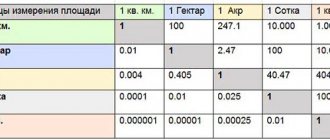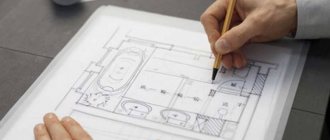Differences between living space and general space
Total area (TA) is the sum of square meters of all premises available in the apartment, regardless of their purpose, which are used to make payments for utility bills, in property purchase and sale agreements and for other purposes.
When conducting a transaction with a real estate property, as a rule, two terms appear in the documents - residential and total area. Even though it is easy to distinguish between them, some still make mistakes when using them.
It is important to know: The total square footage is the entire square footage of the apartment, which, according to documents, is classified as a given property, and the living space means only rooms suitable for habitation.
Below is the answer to the question what is the difference between the living area and the total area of an apartment:
- Dimensional parameters. The residential area represents only a part of the total, i.e. its size is smaller. Most often, this difference is significant; sometimes the footage for housing is equal to half of the total.
- Living space includes rooms (bedrooms, children's rooms, living rooms) where people spend most of their time at home. In addition to them, the OP includes all other square meters of housing.
- Purposes of use. The size of residential premises influences the living conditions of citizens (the possibility of receiving social benefits, adopting a child, etc.). The market value of housing, the amount of utility bills and contributions (for heating, major repairs) depend on the OP.
Below is information on how to calculate the area of an apartment by total footage.
How to correctly measure the total area?
If you plan to calculate the OP yourself, you need to understand all the nuances in detail. The total area of the apartment is the sum of all heated premises for various purposes.
Residential:
- bedroom;
- children's;
- living room.
auxiliary:
- kitchen;
- kitchen area;
- corridors;
- hallway;
- halls;
- bathroom, shower;
- restroom;
- bathroom;
- built-in pantries and cabinets, etc.
Additional:
- wardrobe;
- dining room;
- gaming;
- study;
- library, etc.
In fact, measuring an apartment is a very difficult task, the implementation of which must be approached extremely responsibly. The OP value is used when buying and selling real estate. The utmost accuracy of calculations is important. If you have never had to deal with such tasks before, we recommend using the services of professionals. They will not only take correct measurements and calculate the total area of the apartment in a new building, but will also prepare all the necessary papers. The specialists' report is a compelling argument that can be used in court. Although, if the developer reads the documents, he will not delay resolving the dispute. You can save money and nerves.
What's included
The total square footage includes all the premises that make up a housing unit in an apartment building:
- Residential premises (rooms). These are bedrooms, living rooms, children's rooms, where people sleep, work, relax - spend their leisure time at home.
- Kitchens. Regardless of the amount of time residents spend in the kitchen, this room is still classified as a household room and is included in the total area. Even if the owner decided to arrange a place to relax there and spends all his free time there, this does not affect the purpose of the kitchen.
- Corridors that connect the rooms inside the apartment with each other.
- Rooms for sanitary purposes (bathrooms, toilets) do not belong to living space. They are part of the overall footage.
- Wall closets also belong to the OP, despite the fact that residents, as a rule, do not go into them at all.
- Niches in the walls of Stalin-style houses designed for storing food in winter, instead of a refrigerator.
What else should you consider?
Over the past few years, this area in the legislation of the Russian Federation has undergone virtually no changes. If the norms become different, it is only within a specific region; the amount of change is rarely large. But more often than not, even other cities repeat the same rules that apply in Moscow.
Rationing of living space began in our country since the times of the USSR. And many of the rules in force at that time are still applicable to practice today. Even after changes, they are simply transferred to new documents. Only the government bodies responsible for editing in a given case change.
It is worth considering that some categories of citizens have the right to receive compensation. For example, if they and their family members were injured during the accident at the Chernobyl station. Compensation is especially relevant for those who are interested in the opportunity to save on utility bills. Labor veterans who permanently reside in housing stock also have this right. Regardless of what form of ownership they register for a particular object.
Many citizens can independently improve their living conditions. But for some, government support remains relevant. If there is an opportunity to get housing on preferential terms, why not take advantage of it?
What doesn't turn on
Some people mistakenly believe that when calculating the total area of an apartment, all premises of the property should be included, but in this case there are exceptions. The following square meters are not included in the accounting of the OP:
- Balconies, loggias. Until recently, they were taken into account with a reducing factor - 1/2 from the loggia and 1/3 from the balcony were included, but now they have been excluded from the calculation completely.
- Verandas, terraces. These places are intended for a person to relax and engage in his hobby (for example, growing flowers). Therefore, they are not taken into account when calculating the total footage.
- Niches with a height of less than 1.8 m. Thus, low wall cabinets are not included in the OP.
- The place under the stairs with a span height of less than 1.6 m from the floor (the distance must be measured with a tape measure at right angles to the floor). This applies to two-level apartments.
- Stoves and fireplaces. Even if they are in working order, the space under them is not included in the total area.
- Doors and arched structures less than 2 meters wide, i.e. they have a very low threshold. Therefore, it is not advisable to include them in the OP.
- Premises without heating, when the total square footage needs to be calculated in order to calculate the amount of payments for heating and check the calculations of the housing company.
How is the living area of an apartment calculated?
The living area of the premises is defined as the sum of the sizes of all living rooms. The registration certificate for real estate contains all the dimensional data of premises for various purposes. When purchasing real estate, it is enough to check the square footage of rooms and utility rooms. This is relevant if no redevelopment has been carried out.
Often, owners improve their living space to create more comfortable living conditions. By reducing the size of housing, built-in wardrobe structures are made or the spaces of rooms are combined. Widening doorways or installing arches is common.
You should carefully consider these facts when purchasing a home.
All these alterations fall under the concept of “reconstruction” and require permission to carry out the work.
If you have any doubts when purchasing, you can find out and calculate the living area of the apartment yourself. It is necessary to measure the square footage of the rooms along the inner perimeter of the walls and add them up - we get the desired value. Partitions that enter residential premises are not included in the calculation.
Calculating the living space of rooms of non-standard shape can be puzzling. In this case, we divide the entire perimeter of the room into familiar shapes: squares, rectangles, triangles. We find the arithmetic value of the area of each figure, sum them up and get the result.
If the room has a recess in the form of a niche, then, by law, it is included in the area of the living room if its height is more than two meters. The size of stoves and fireplaces is excluded from residential meters.
Formula applied
Let's look at the example of determining the living space of a standard three-room apartment with a balcony. Room sizes are 20, 18, and 15 square meters. m, kitchen – 9 sq. m, bathroom – 8 sq. m, toilet - 5 sq. m, corridor – 2.5 sq. m, balcony – 3 sq. m. Total amount (calculated without balcony):
20+18+15+9+8+5+2.5=77.5 sq. m.
Living area is: 20+18+15=53 sq. m.
Does a balcony or loggia count?
When calculating residential square meters of an apartment, the dimensions of balcony structures and loggias are not taken into account. However, if the redevelopment was carried out legally, and the copyright holder insulated and combined the balcony or loggia with the living room, then these meters will be added to the living area. In this case, the owner must have the appropriate document for the redevelopment and a registration certificate for the home ownership, prepared after the refurbishment, which indicates all the changes made.
If illegal redevelopment takes place in a real estate purchase and sale transaction, then it is better to refuse the purchase, since this housing cannot participate in mortgage lending, inheritance, or gift. When buying such an apartment, you should think about whether you need to buy so many problems with it. If you yourself are thinking about this issue, then do not remodel without obtaining permits.
How to officially make a payment
Calculation of housing sizes is carried out for a specific purpose:
- real estate transaction;
- calculation of the amount of building materials for construction or finishing;
- registration of ownership;
- production of technical passport:
- obtaining permission for reconstruction or redevelopment;
- rental.
Expert opinion
Mironova Anna Sergeevna
Generalist lawyer. Specializes in family issues, civil, criminal and housing law
In all cases, an error in calculations can play a cruel joke: there will not be enough building materials for repairs or construction, permission for alterations will be denied, or an inaccuracy will creep into the purchase and sale agreement, and the transaction may be declared invalid.
A safe and correct decision would be to contact a company licensed to carry out measurements. Such organizations have all the technical means to carry out accurate calculations and an appropriate set of instruments to perform these tasks.
Calculation rules
How to calculate the total area of an apartment is given below. This calculation is not difficult - you need to measure the area of all the rooms included in it and summarize the results. But there are some nuances that should be taken into account:
- To calculate the square footage of a rectangular room, you need to measure the lengths of its 2 walls, which are connected to each other. After this, the resulting numbers must be multiplied.
- A complex-shaped room can be mentally divided into rectangles, their areas can be calculated by analogy with the first option, and added. The result obtained will be equal to the area of the room.
- If the room has diagonal walls, then you should proceed in the same way: divide it into imaginary rectangles. That part, one of the sides of which is a wall at an angle to the other walls, will be a right triangle. Its area is equal to half the product of its legs (walls forming a right angle). Add all the obtained values together.
Recommendation: It is better to draw rectangular figures that are taken into account on paper using a ruler. This action will help reduce the likelihood of errors.
Room measurements must be taken from inside the room using a tape measure, applying it to the junction of the wall and the floor. It is better to perform these steps together for convenience.
Preparatory work
The tools you will need are a pen or pencil, a notepad for making calculations, a calculator, as well as an ordinary tape measure, a regular and long metal ruler, which is necessary to check the curvature of the walls.
To begin with, professionals advise making sure that the room has the correct geometric shape. A square room is measured along the walls; if it is rectangular in shape, you just need to compare the diagonal lines of its opposite sides, they must be parallel and equal, then we can talk about an equilateral rectangle.
In the latter case, the furniture from the middle of the space will need to be moved away. The same should be done if you decide to use a laser tape measure - nothing should interfere with the passage of its beam. It is certainly more convenient to work with such a device, but with a complex configuration and many protrusions, its use is fraught with many difficulties.
Interesting fact! The most expensive housing is considered to be in Hong Kong - for $150 you can rent a cell with 2.5 square meters. m, it is possible to purchase a one-room apartment for 1 million rubles.
Legislative basis
All issues that relate to residential premises in apartment buildings are regulated by the Housing Code of the Russian Federation.
Also, if the need arises, you can refer to such regulatory documents as:
- Construction norms and rules (SNiP) from 2003.
- Federal Law No. 384 of December 30, 2009, which presents technical regulations for the safety of buildings and structures.
Important: The priority of regulation among these documents belongs to the latter (Federal Law No. 384). Thus, its provisions may cancel the effect of some clauses of the RF Housing Code and SNiP 2003.
When studying the Housing Code in order to calculate the square footage of an apartment, it is especially necessary to highlight Article 15, which provides a definition of what exactly is the object of housing rights.
Controversial issues
It is advisable to familiarize yourself with them first. How is the total area of an apartment determined? Should balconies and loggias be taken into account in the calculation? How are different situations regulated? There are two main legislative acts that regulate the determination of housing area. This:
- housing code 2005;
- SNiP 2003 “Residential multi-apartment buildings”.
It should also be taken into account that some of the provisions described in these documents were declared repealed in 2009 by Federal Law 384-FZ. Let's go through the main important points of the housing code:
- Art. 15, paragraph 5 - the basis for calculations of residential premises. The total area of the apartment consists of the sum of all areas. This includes rooms and utility rooms that are designed to meet the needs and requirements of the apartment owners. Terraces, balconies, loggias and verandas are not included in the total area.
- Art. 16, paragraph 1 – definition of types of residential premises: residential buildings or parts thereof, apartments, rooms.
- Art. 16, paragraph 3 – formulates the concept of an apartment as a structural room that is separate in nature and located in an apartment building, with direct access to common areas. The components of an apartment are one or more rooms, auxiliary premises designed to satisfy household needs.
According to the above SNiP, the determination of the total area of the apartment put into operation is based on the external dimensions. Here we are already talking about including a balcony and loggia.
When calculating area, it is recommended to use the following coefficients:
- 0.5 for the loggia;
- 0.3 for balconies and terraces;
- 1 for cold storerooms and verandas.
It should be borne in mind that SNiPs are not the main document. The Housing Code in this case is more important, and you should focus exclusively on it.
Many officials today insist on adding extra square meters to the living area. Therefore, property owners are interested in whether the loggia is included in the total area of the apartment. If the calculations are based on the 2003 standards, then such a possibility is provided there. However, one should still be guided by a more important document, such as the Housing Code of the Russian Federation. According to this regulatory act, the balcony is excluded from the total area of the residential premises.
According to the Housing Code and SNiP, partitions are considered part of the main and auxiliary premises, therefore their size is part of the total area of the apartment in sq. m.
In our country, current laws and regulations change quite often, so there can be a lot of questions related to determining the area of living space. Most of the features of calculations are regulated by various documents and regulations, which may contradict each other. This can cause certain difficulties for ordinary people.
What does OP influence?
Some important points depend on the size of the apartment’s OP:
- The cost of the property for the buyer. An inexperienced person, when looking for housing, may mistakenly focus on the value of the OP. When choosing an option suitable for purchase, you should first of all concentrate on the size of the living space.
- Amount of heating payments. Utilities calculate based on total footage.
- The amount of contribution for major home repairs. The amount of payment for general building repairs directly depends on the square footage of the entire apartment of each specific owner.
- Comfort of living. The size of the living space has a direct impact on the comfortable living conditions of each person. But the OP is no less important, since it also includes other rooms that play an important role for the convenience of living (bathrooms, storage rooms, cabinets in niches, kitchen).
OP is an important parameter for the apartment owner. Many aspects depend on it: from the market price to the comfort of living. The general quadrature should be distinguished from the residential quadrature, which includes only living rooms. The main legislative document regulating issues related to the square footage of citizens' housing is the Housing Code of the Russian Federation. It also provides an answer to a fairly popular question among citizens, whether the loggia is included in the total area of the apartment. The regulatory document clearly states which premises are included in the OP and which are not. This parameter is calculated by calculating the square footage of each room of the property.
total area
What do you need to know about this? The first thing you should decide on is the total area of the apartment. These may or may not be habitable. These may simply be premises that are directly related to the proposed property. Often sellers and real estate agents resort to tricks and indicate the total area of the premises as living space. This is not entirely true, since it also includes balconies and loggias. Therefore, this parameter must be specified separately.
Floor footage
Such calculations are needed to determine the square footage of the room as a whole during major repairs, as well as, if desired, to update the flooring or carry out thermal insulation work.
The principle of the procedure exactly repeats the measurement of vertical surfaces. For convenience, the floor is divided into sections formed by irregularities and bends, conventionally, these are geometric shapes (triangles, trapezoids, squares), the squaring of which will add up to the total area. It is not necessary to clear the center of the room from furniture, because the length and width of the base are freely determined by the walls, which have the same values.
So, the area of a room is the number of square meters of floor, walls and ceiling, it is always measured in square meters, including length and width, excluding height.
Many owners are puzzled by how to calculate the area of a room
with a non-standard configuration of the room and ceilings. In this case, the measurement process is similar to working with a room of the correct shape; also, in almost all cases, you can use the mathematical formula - S=a·b.
An important point is related to the selection of finishing materials and their quantity. The volume of purchase and the number of unnecessary trimmings depend on the maximum accuracy of calculations. Difficulties may also arise when choosing a finish with a certain ornament.
Calculations are quite difficult for those who are forced to independently determine the footage for the first time. The process can take a long time, and there are no guarantees of accuracy! Many people complain that some parameters do not match, especially when problems often arise when the shape of the room is incorrect. All these annoying situations can be avoided by ordering a comprehensive repair from a company with a good reputation. You should not engage in a task that is unusual for yourself - hired employees will do such calculations themselves, in addition to rough and finishing work, and at the same time save the customer’s money.
How to calculate the area of ceilings and walls
The ceiling area is usually equal to the floor area, with the exception of multi-level ceilings, so it does not need to be calculated separately.
S walls are most often needed to determine the number of ceramic tiles or rolls of wallpaper.
- If all the walls are covered with wallpaper or tiles, then it is easier to first calculate the total perimeter of the room P by adding up all the lengths of its walls. P = 2 * (a + b).
- Then P must be multiplied by the height of the walls h. We get the total area of all walls S.
- Now from S walls subtracts S windows and doorway, previously calculated using formula (1).
Thus, S for finishing is determined by the following formula: S dep. = (2 * (a + b) * h) - S windows - S doors (6).
If partial finishing is carried out, then the surface area of the wall intended for finishing is calculated.
An example of how to find the area S dept. for a wall with a door:
S dept. = S walls – S doors = 4 * 2.7 – 1 * 2.1 = 8.7 m2.
How to calculate how many tiles you need for an apron
- To lay out a tile backsplash in the kitchen, you must first mark it and measure its length and height.
- Then, using formula (1), we calculate the area of the apron.
- To calculate the number of tiles, it is necessary to divide S of the apron by S of one tile: N pl. = S fart. / S pl. one tile (7).
- Another 5 - 10% must be added to the calculated amount N, taking into account the cutting of corner tiles and the inevitable part of the material being consumed (part of the tiles is rejected by the tile cutter).
That is, the total quantity will be equal to: N total. = N pl. + N pl. * (0.05 - 0.1) (8).
The number of tiles for the bathroom, if they cover all the walls, is calculated using the method described above:
- using formula (6) we calculate S of the finishing surface of the walls;
- according to f‑lams (7) and (8) - the number of tiles.
How to count the number of wallpapers
Calculating the required amount of wallpaper is more complicated, since it is necessary to take into account:
- wallpaper pattern step;
- cutting stock
The number of rolls is calculated in two ways:
- by wall area;
- along the perimeter of the room and the number of canvases.
There are ready-made wallpaper calculation tables.
First calculation method
The first method is simple, but it is very approximate, so you have to buy wallpaper in large quantities, which is not economical.
- The surface area of the finish S dept is calculated. minus windows and doors - according to f‑le (6).
- The area of one roll is determined: the length of the roll is multiplied by its width. For example, if there are 10 meters of fabric in a roll 60 cm wide, then S of one roll will be 6 m2.
- Then we divide S dept. per S of one roll, and round the resulting figure to a whole number.
- We add one or two rolls to the reserve.









